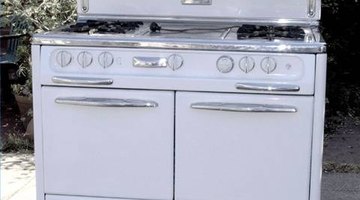History of Gas Stoves
The gas-burning stove has long been one of the cooking methods of those in America and other countries. There have been some dramatic changes in the styles and mechanics of the stove over time.
Brief History of Stoves


The gas stove was not the first that was ever created. Before the gas stove, there were German-designed, five-plate, or Jamb, stoves in the 1720s. Following that German design, Benjamin Franklin invented the "Franklin Stove," or the iron furnace stove. Later came the first sootless stove, a kerosene version designed by Frans Wilhelm Lindqvist. The coal stove arrived on the scene in 1833, invented by Jordan Mott. The baseburner, as it was called, used ventilation to burn coal efficiently. In 1826, however, a full seven years earlier, the British inventor, James Sharp, created the gas-burning stove.
The Dangers of Antique Gas-Burning Stoves

Early gas-burning stoves did not have a pilot light, and therefore, had to be lit with a match. If the door was closed and the gas was left on, the gas could fill the oven chamber and spread throughout the room. A simple electrical arc, or the lighting of a pipe, could ignite the gas in the room, triggering an explosion. Gas stove manufacturers later installed a safety valve in the ovens to prevent these unfortunate accidents. These safety valves remain in gas-burning stoves even today. An added safety feature is the electrical ignition of the pilot light--the click you hear just before the flames appear.
Functionality of the Gas-Burning Stove

The turn of the 20th century found many women still using coal-burning stoves--starting fires each morning, constantly tending the fires, emptying ashes and applying waxy black polish to keep the stoves from rusting. All of this took an hour or more, and no cooking was involved yet. Gas-burning stoves took a much smaller amount of work to maintain and could therefore reduce a woman's time in the kitchen.
Although gas companies already marketed piped gas for the illumination of cities and homes, it was decided that if the gas-burning stove was here to stay, then the gas companies must expand their product lines, thereby providing the needed gas for stoves, by piping the gas into individual homes.
Features of the Gas-Burning Stove

Perhaps the most outstanding feature of a gas-burning stove is that its surface remains largely cool when cooking. Instead of being forced to choose a coal-burning stove that could produce potential burns, customers could choose the smaller gas-burning variety. In 1915, a major development for the gas-burning stoves was introduced--a thermostat for the oven. In addition, about the same time, natural gas was introduced for use in gas-burning stoves. This natural gas proved to be cheaper and less toxic for those around. Gas-burning stoves outnumbered coal or wood-burning stoves two to one by 1930.
Modern-Day Gas Stoves

Most gas stoves today come equipped with gas burners and an electric oven. Having gas burners allows a cook to have total control over the heat that is applied to food. Gas ovens don't heat as evenly as electric ovens, but they prevent the drying out of cakes and brownies more efficiently. Overall, gas-burning stoves are about equal to other types of stoves on the market.
Resources
Writer Bio
Marsanne Petty has been a writer and photographer for over ten years, and is currently pursuing the combination in tandem. She attended Madison Community College, receiving a degree in Administration. She has published several articles for magazines, including Jack Magazine, and the local newspaper, the Jasper News. Her latest creation, a pictoral history of Hamilton County, Florida, was published in early 2009 through Arcadia Publishing.
Photo Credits
- Flickr Creative Commons
More Articles



